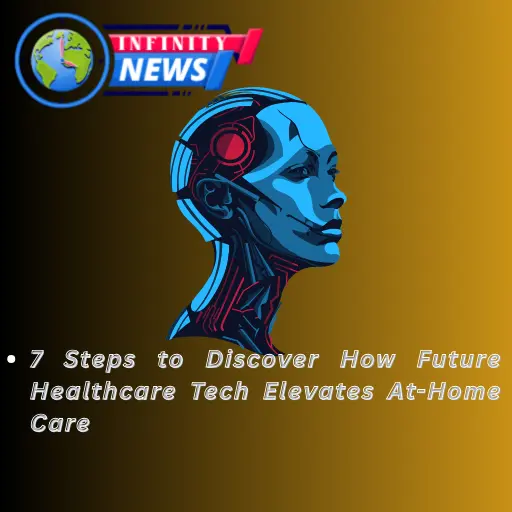7 step how future healthcare technology is elevating at-home care?
how future healthcare technology is elevating at-home care is evident through AI-powered healthcare solutions, telemedicine, and wearable health technology. Gone are the days when a hospital visit was the only option for medical care. Today, these innovations are making it possible to receive quality treatment from the comfort of home, ensuring better accessibility, real-time monitoring, and personalized care for patients.

This shift toward at-home healthcare is driven by advancements in remote patient monitoring (RPM), smart health devices, and robotics. The COVID-19 pandemic accelerated this transformation, highlighting the need for accessible and efficient virtual healthcare services. Now, with technologies like AI-driven diagnostics, Internet of Medical Things and predictive analytics, home-based care is becoming more personalized and proactive than ever before.
Additionally, breakthroughs in augmented reality (AR), virtual reality (VR), and AI-powered chatbots are enhancing remote consultations, making healthcare more interactive and engaging. Blockchain technology is also stepping in to ensure patient data security, addressing one of the biggest concerns in digital healthcare.
1. emerging home care: The Brain Behind Home Care Advancements
Artificial intelligence (AI) is transforming at-home healthcare, making medical services smarter and more efficient. With AI-driven diagnostics, patients can receive accurate health assessments without visiting a hospital. Machine learning algorithms analyze symptoms, predict potential health risks, and offer personalized treatment plans.

One of the most exciting innovations is AI-powered virtual doctors and chatbots, which provide instant medical advice, monitor patient conditions, and even remind users to take their medications. These healthcare chatbots make remote care more accessible, especially for elderly patients and those with chronic conditions.
Another major breakthrough is predictive analytics in healthcare. By analyzing patient data, AI can detect early signs of diseases such as diabetes, hypertension, and heart conditions, allowing for preventive treatment. This reduces hospital visits and improves long-term health outcomes. AI is also enhancing mental health support by offering virtual therapy sessions and mood-tracking apps. These tools help individuals manage stress, anxiety, and depression from home.
2-The Digital-First Approach: Telemedicine & Virtual Healthcare
Telemedicine has revolutionized at-home healthcare, providing virtual consultations and remote patient monitoring without the need for in-person visits. With the rise of 5G networks, telehealth services have become faster, more reliable, and accessible in remote areas. High-speed connectivity enables real-time video consultations, smooth data transfer from wearable health devices, and seamless integration of AI-driven diagnostics into telemedicine platforms.

Emerging technologies like Augmented Reality and Virtual Reality in healthcare are enhancing remote consultations. Doctors can now use 3D imaging and AR overlays to guide patients through medical procedures at home, improving accuracy and patient understanding.
A groundbreaking innovation is holographic healthcare assistants AI-powered virtual doctors that interact with patients in real-time. These smart healthcare assistants can provide personalized patient care, answer health-related queries, and support remote patient monitoring (RPM), making future healthcare technology even more immersive and efficient. As telemedicine technology evolves, AI-powered virtual healthcare solutions will continue reshaping home-based care, making healthcare smarter and more accessible.
Next-Gen Smart Wearables & Home Healthcare Devices
The future of at-home healthcare is being reshaped by next-gen smart wearables and AI-powered health devices designed for real-time monitoring and early disease detection. These advancements are making home-based care more proactive, helping individuals manage their health with greater accuracy and convenience.
emerging home care Bio-Sensors for Real-Time Health Tracking
Wearable health technology, such as smartwatches, fitness trackers, and bio-sensors, now go beyond step counting. These devices track real-time heart rate, oxygen levels, blood pressure, and even early signs of cardiovascular issues. The integration of AI-powered healthcare solutions helps predict potential health risks and alerts users before conditions worsen.
AI-Driven Smart Bandages for Wound Monitoring
A breakthrough in remote patient monitoring (RPM) is the development of AI-driven smart bandages. These bandages track healing progress, detect infections, and adjust moisture levels to speed up recovery all without a hospital visit. This technology is particularly beneficial for diabetic wound care and post-surgical patients.
The Rise of Smart Toilets and Mirrors in Health Diagnostics
Smart home healthcare devices are expanding beyond wearables. AI-powered smart toilets analyze urine and stool samples to detect early signs of kidney disease, diabetes, and digestive disorders. Similarly, smart mirrors with integrated facial recognition and thermal imaging can monitor skin conditions, hydration levels, and stress indicators.
As the Internet of Medical Things continues to grow, these AI-driven home healthcare innovations will make personalized healthcare at home more effective and accessible than ever before.
Robotics & AI-Powered Assistants in emerging home care
The integration of robotics and AI-powered healthcare solutions is revolutionizing at-home patient care, especially for elderly individuals and those with disabilities. From caregiving robots that provide companionship to AI-powered exoskeletons that restore mobility, these innovations are making home healthcare more efficient, personalized, and independent.
The Role of Caregiving Robots for Elderly and Disabled Patients
AI-powered caregiving robots are transforming home-based elderly care by offering real-time health monitoring, medication reminders, and even emotional support. These robots assist with daily tasks such as lifting, feeding, and mobility, reducing reliance on human caregivers. Companion robots like SoftBank’s Pepper and Ellis engage seniors in conversation, helping combat loneliness and cognitive decline.
AI Exoskeletons for Mobility Support
For individuals with limited mobility, AI-powered exoskeletons provide a breakthrough solution. These robotic wearables assist in walking, standing, and muscle rehabilitation for stroke survivors and patients with spinal cord injuries. Advanced AI algorithms adjust to the user’s movement, offering personalized mobility support that enhances independence and recovery.
How Japan Is Leading in Robotic Healthcare Advancements
Japan is a global leader in robotic healthcare technology, driven by an aging population and a shortage of caregivers. Companies like Cyberdyne and Toyota have developed robotic exoskeletons to aid mobility, while Honda’s A simo and SoftBank’s AI assistants are enhancing home-based patient care. These innovations are setting global benchmarks, demonstrating how AI-driven robotic healthcare can improve quality of life.
As robotics in healthcare advances, AI-powered assistants will become an essential part of home healthcare solutions, offering independence, support, and safety to those in need.
The Future of Home Healthcare: Predictive and Personalized Medicine
The next wave of at-home healthcare technology is shifting towards predictive and personalized medicine, allowing treatments to be tailored to each individual’s genetic makeup and health history. With AI-driven DNA analysis, digital twins, and predictive analytics, healthcare is becoming more proactive, preventing diseases before they arise.
AI-Driven DNA Analysis for Personalized Treatments
Advancements in AI-powered genetic testing are making precision medicine a reality. By analyzing a person’s DNA, lifestyle, and medical history, AI can predict their susceptibility to diseases like cancer, Alzheimer’s, and heart conditions. This enables doctors to create customized treatment plans that are more effective and reduce adverse reactions. Patients can now receive at-home genetic testing kits, allowing them to take control of their health with AI-driven predictive healthcare.
Digital Twins in Healthcare: Virtual Simulations of Real Patients
A revolutionary development in AI-powered healthcare is the creation of digital twins—virtual models of real patients that simulate their biology, genetics, and health conditions. These AI-driven virtual simulations help doctors test treatments before applying them to real patients, ensuring more accurate and personalized home healthcare solutions. Digital twin technology is expected to revolutionize chronic disease management, drug development, and remote diagnostics.
How Predictive Analytics Can Reduce Hospitalizations
Predictive analytics in healthcare is using big data, AI, and machine learning to analyze patient records and detect early signs of potential health issues. By monitoring patterns in wearable health devices and smart home healthcare tools, AI can predict flare-ups of diabetes, heart disease, or respiratory conditions, allowing for early intervention at home. This reduces hospital visits, lowers healthcare costs, and improves long-term health outcomes. As future healthcare technology continues to evolve, predictive and personalized medicine will transform home-based patient care, making treatments smarter, faster, and more effective than ever before.
Overcoming Challenges in Digital Healthcare
While future healthcare technology is advancing rapidly, several challenges must be addressed to ensure equitable and effective at-home healthcare solutions. Issues like technological accessibility, AI bias, and regulatory concerns play a critical role in shaping the future of digital healthcare.
Technological Accessibility Issues (Rural vs. Urban Patients)
One of the biggest challenges in AI-powered healthcare is the digital divide between urban and rural areas. While 5G networks and telemedicine services are expanding, many remote regions still lack access to high-speed internet and advanced healthcare devices. Without proper infrastructure, rural patients face difficulty using remote patient monitoring (RPM), AI-driven virtual consultations, and wearable health devices. Expanding affordable telehealth solutions is key to closing this gap.
AI Bias in Diagnostics and Patient Care
AI-driven diagnostics and predictive analytics are revolutionizing home-based patient care, but they come with risks. AI bias in healthcare can lead to misdiagnosis, particularly among underrepresented populations. If AI algorithms are trained on limited or non-diverse medical data, they may provide inaccurate diagnoses or treatment recommendations. To address this, healthcare AI must be trained on diverse datasets, ensuring fair and accurate healthcare delivery for all.
Regulatory Challenges in Telemedicine and Remote Monitoring
As telemedicine and remote healthcare grow, regulations struggle to keep up. Issues like cross-border telehealth licensing, patient data privacy, and AI compliance create legal hurdles. HIPAA and GDPR regulations ensure data security, but global telemedicine policies must be standardized to provide seamless virtual healthcare. Additionally, AI-powered healthcare solutions need proper oversight to maintain ethical, safe, and effective patient care.
FAQs About how future healthcare technology is elevating at-home care
1. How is AI transforming at-home healthcare?
AI is enhancing remote patient monitoring (RPM), AI-driven diagnostics, and telemedicine by providing real-time health tracking, predictive analytics, and virtual consultations. AI-powered chatbots, wearable health devices, and smart assistants are making home-based healthcare more efficient and personalized.
2. What role does 5G play in telemedicine?
5G enables high-speed, real-time video consultations, seamless data transfer from wearable health devices, and AI-assisted diagnostics. It ensures faster, low-latency connections, making telehealth services more reliable even in remote areas.
3. Are smart wearables reliable for health tracking?
Yes, next-gen smart wearables use AI-driven bio-sensors to track heart rate, oxygen levels, blood pressure, and even detect early signs of chronic diseases. While not a replacement for doctors, they assist in proactive health management.
4. What are AI-powered exoskeletons, and how do they help?
AI exoskeletons are robotic wearables that support mobility for patients with spinal injuries, stroke recovery, or muscle weakness. They use AI-powered movement assistance to help individuals walk, improving their independence.
5. How do AI-driven smart bandages work and how future healthcare technology is elevating at-home care
Smart bandages use AI and sensors to monitor wound healing, detect infections, and adjust moisture levels. This helps patients especially diabetics and post-surgical patients—heal faster without frequent hospital visits.
Final Verdict: how future healthcare technology is elevating at-home care
The rapid advancements in AI-powered healthcare technology are reshaping at-home patient care, making it more personalized, predictive, and accessible. From telemedicine and AI-driven diagnostics to robotic caregivers and smart health devices, the future of healthcare is shifting toward a digital-first, patient-centric model.
However, challenges such as technological accessibility, AI bias in healthcare, and regulatory barriers must be addressed to ensure equitable and ethical implementation. Countries like Japan are leading in robotic healthcare, while 5G networks and predictive analytics are pushing telemedicine innovations forward.
The key takeaway? At-home healthcare is evolving beyond basic remote care—it’s becoming a proactive, AI-enhanced system that focuses on early detection, personalized treatment, and continuous monitoring. With further advancements, future healthcare technology will not only improve patient outcomes but also reduce hospitalizations and healthcare costs.
For More information visit website
